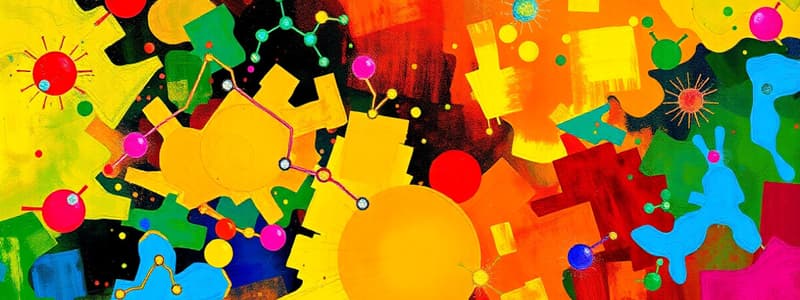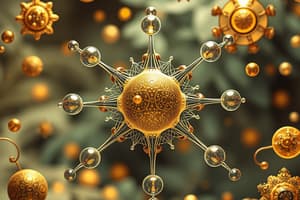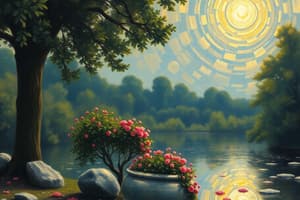Podcast
Questions and Answers
What type of molecule is formed by two atoms of the same element, such as oxygen?
What type of molecule is formed by two atoms of the same element, such as oxygen?
- Molecule (correct)
- Element
- Ion
- Compound
Which of the following substances is classified as an ionic compound?
Which of the following substances is classified as an ionic compound?
- Water
- Sodium Chloride (correct)
- Carbon Monoxide
- Sugar
What distinguishes a covalent bond from an ionic bond?
What distinguishes a covalent bond from an ionic bond?
- Ionic bonds are always stronger than covalent bonds.
- Covalent bonds conduct electricity when dissolved in water.
- Ionic bonds only occur in gases, while covalent bonds occur in liquids.
- Covalent bonds share electrons while ionic bonds transfer electrons. (correct)
What defines a pure substance?
What defines a pure substance?
Which of the following statements is true about elements that prefer to be alone, such as helium and neon?
Which of the following statements is true about elements that prefer to be alone, such as helium and neon?
What is a defining characteristic of a compound in chemistry?
What is a defining characteristic of a compound in chemistry?
Which of the following is an example of a mixture?
Which of the following is an example of a mixture?
What occurs when sodium chloride and water are mixed?
What occurs when sodium chloride and water are mixed?
How many carbon atoms are there in one molecule of sucrose?
How many carbon atoms are there in one molecule of sucrose?
What characteristic of mixtures distinguishes them from pure substances?
What characteristic of mixtures distinguishes them from pure substances?
Flashcards
Molecule
Molecule
A group of two or more atoms held together by chemical bonds.
Compound
Compound
A substance made up of two or more different elements chemically combined in a fixed ratio.
Covalent bond
Covalent bond
A type of chemical bond formed by the sharing of electrons between atoms.
Ionic bond
Ionic bond
Signup and view all the flashcards
Sodium chloride (NaCl)
Sodium chloride (NaCl)
Signup and view all the flashcards
Pure Substance
Pure Substance
Signup and view all the flashcards
Mixture
Mixture
Signup and view all the flashcards
Distillation
Distillation
Signup and view all the flashcards
Sucrose
Sucrose
Signup and view all the flashcards
Study Notes
Elemental Personalities
- Some elements are shy and prefer solitude (e.g., helium, neon).
- Other elements are sociable and interact with others (e.g., carbon, oxygen, hydrogen).
Building Molecules & Compounds
- Molecules are formed when atoms (elements) bond together.
- Molecules can be composed of atoms of the same element (e.g., O2) or different elements (e.g., CO).
- Compounds are groups of molecules.
- Compounds can be classified by bond type (ionic or covalent) and whether they are pure substances or mixtures.
Chemical Bonds: Ionic vs. Covalent
- Ionic bonds: Compounds conduct electricity when dissolved in water. Molecules break into charged particles (ions).
- Covalent bonds: Compounds do not conduct electricity when dissolved in water. Electrons are shared by atoms in the molecule.
Compounds in Everyday Life
- Salt (NaCl) is an ionic compound.
- Sugar (sucrose) is a covalent compound.
Pure Substances vs. Mixtures
- Pure substances consist of only one element or compound.
- Mixtures contain two or more elements or compounds that do not chemically bond.
- Components in a mixture retain their individual properties.
- Example: mixing pennies, dimes, and quarters.
- Example: mixing salt and water (water can be boiled off to separate the components).
Studying That Suits You
Use AI to generate personalized quizzes and flashcards to suit your learning preferences.




